Bottle Washing and Rinsing
In
addition to emphasizing the importance of pure water for bottling in his
1888 publication, The
Manufacture and Bottling of Carbonated Beverages, James W.
Tufts also advised: “Pure water should be used for washing bottles, as
well as for manufacturing the beverages, for it is useless to provide
pure water for the beverage if there are impurities left in the bottle
by the water used in washing.”
BOTTLE BRUSHES
Bottle brushes were used to wash


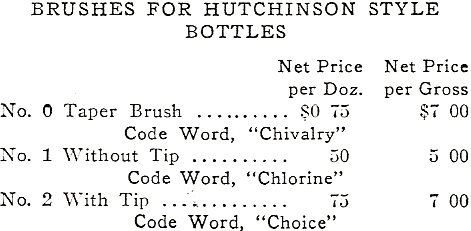
The W. H. Hutchinson and Son
1908
Bottler’s Book
advertised scrub brushes to be used for washing the outsides of bottles.
A layer of cork sandwiched into the two piece wooden handle
caused the brush to float:
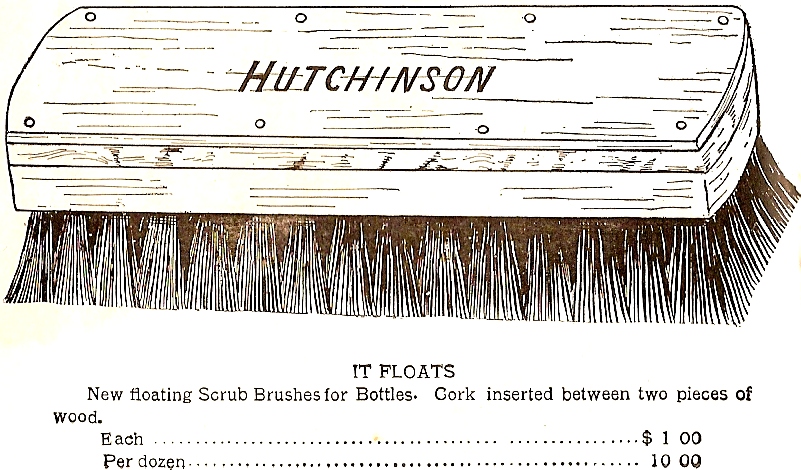
BOTTLE WASHING MACHINERY
Bottle
washing machinery was first introduced in the 1870s.
Most of the early power washers employed a rotating brush for
cleaning the insides of bottles.
Here is an example of a direct belt power washer available per
the 1908 Bottler’s Book
produced by W. H. Hutchinson & Son:
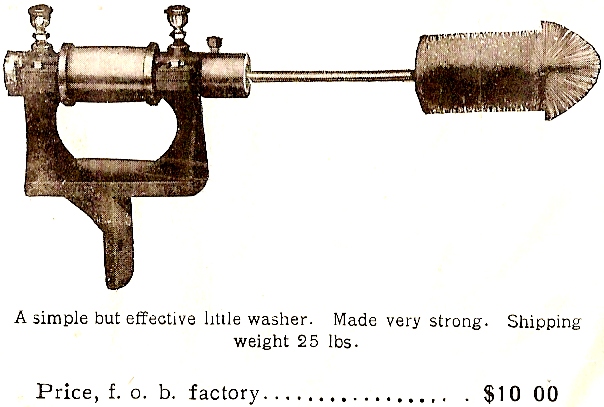
The 1908
W. H. Hutchinson & Son Bottler's Book also offered this more
sophisticated Goulding power bottle washer model:
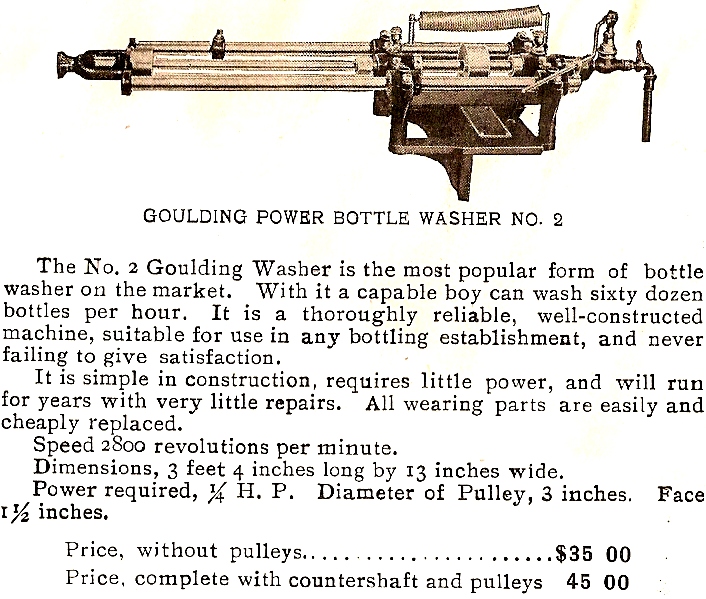
Whew; the “capable boy” washing a dozen bottles per minute was definitely earning his no doubt meager salary!
Larger-sized bottlers required bottle washing
machinery that could be used to clean a substantial quantity of bottles
in a short time period.
Here’s an example of the “Improved Lightning Bottle Washer” offered by
Tufts in 1888:
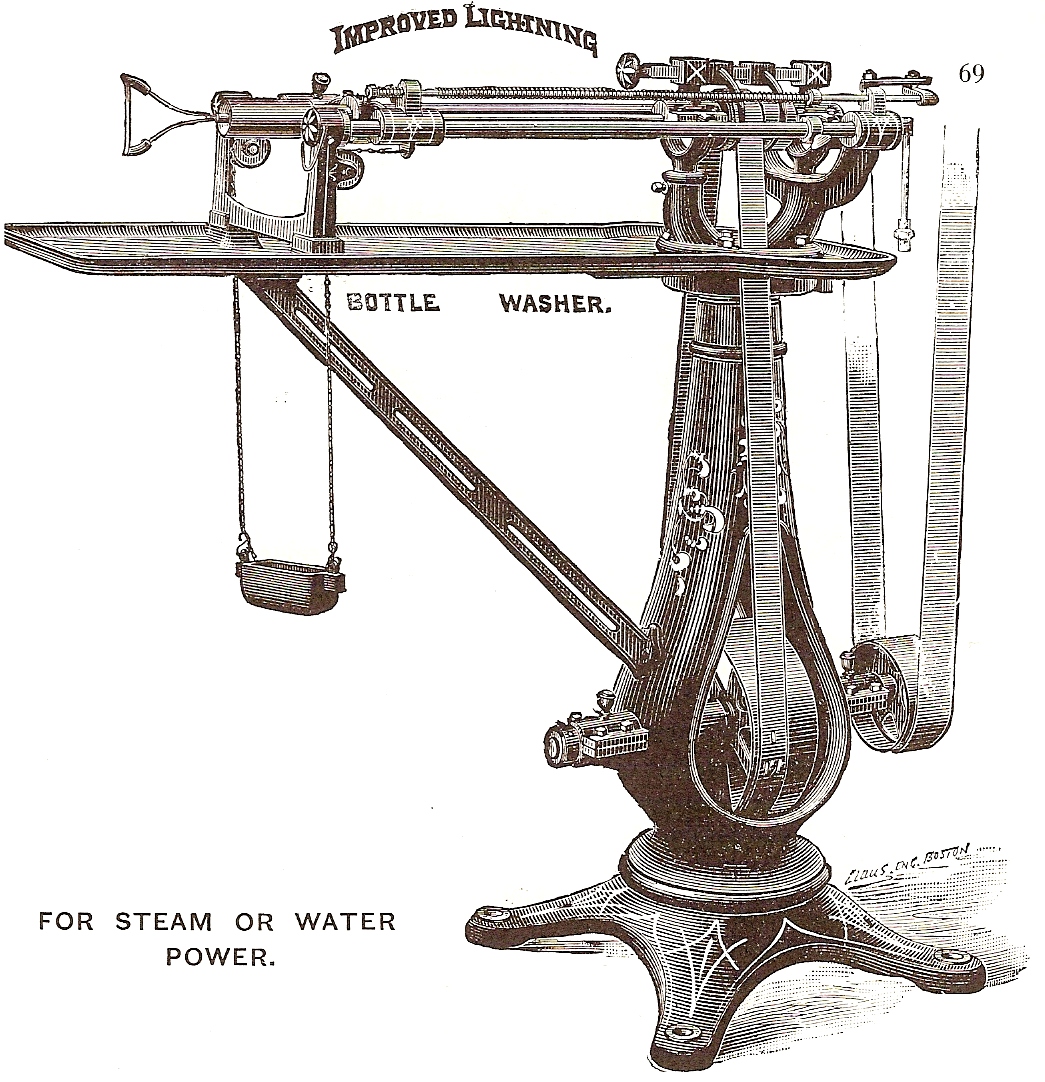
The
advertising copy accompanying Tufts’ advertisement specified:
I have sold to Messrs. Hoyt Bros. & Co., of
With this patent, together with those previously
controlled by Hoyt Bros. & Co., the Lightning Bottle-Washer becomes the
most perfect washer ever produced, and it is now difficult to see where
it can be improved. It is
perfect.
As these patents control essential principles which
all perfect bottle-washers must employ, it is at once apparent that all
washers that are at all serviceable must of necessity be infringements,
and so not safe to buy; while those, if any, that are not infringements
are unsafe to use…Price, $190.00.
Although Tufts claimed this bottle washer was
“perfect,” using it to wash
Some bottlers experimented with washers that shot a
pressurized stream of water into bottles, but the
SHOTTING MACHINES
The most reliable bottle washing equipment bottlers
depended on for cleaning
The following illustrations are from the 1910
W. H. Hutchinson and Son
Bottlers’ Supplies catalog.
Iron shot was 8¢ per pound, steel shot was 10¢ per pound, and
anti-rust cut steel shot was 12.5¢ per pound in 100 pound bags.
W. H. Hutchinson & Son promoted anti-rust steel shot because iron
and steel shot “have been objectionable because they become rusty when
used in water and leave rust stains in the bottles:”
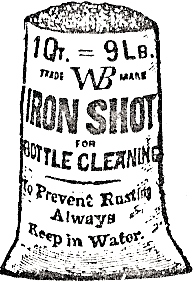

Late in the
Bottle-Washing with Leaden Shot or
Emery.
Leaden shot are very extensively employed for
cleansing bottles…but unfortunately lead is smeary and extremely
poisonous. When bottles are
washed daily with shot a film of black lead will sometimes be formed…In
soda and beer bottles this film cannot be seen, on account of the
colored glass; but occasionally a shot can be seen that has become
wedged in at the bottom of the bottle, and held there, and thus
contaminating the liquid by the chemical action of the beverage on the
lead…shot for washing bottles is not to be recommended; and in our
opinion the cleansing of glass bottles with shot should be absolutely
prohibited where the bottles are intended for beverages.
Iron shot is preferable to lead shot, as it does not
affect the contents of the bottle.
This shot has sharp edges, cleaning the bottle more thoroughly
than lead shot.
Emery…is a very economical and practical substitute
for cleansing bottles, instead of leaden shot.
It occurs native in masses and grains, and is extensively used in
the arts for grinding and polishing metals, hard stones, and glass, and
can be used alone as well as with diluted acids.
It works much more rapidly than shot, on account of its sharp
angles, and is in every way an economical substitute.
Grains No. 5 or 6 are the most suitable for bottle-washing.
These
TO CLEAN STEEL SHOT.
By J. P. Sell,
Steel shot that has rusted together, and in which
a quantity of small particles of glass have accumulated, may be
thoroughly cleansed by placing the same in a pan of hot water.
By Joe Evans, Star Bottling Works,
When shot gets dull looking and leaves bottles
cloudy after shotting, take one-have ounce Citric Acid solution (the
same as you are using in your goods) to 1 pound shot, shake well in
a bottle and they will brighten up like new silver.
TO SAVE SHOT.
By E. W. Barnard,
There is a good deal of shot wasted by the
washers, and I find the best plan to collect the lost shot is to
pick it up with a magnet, which is much quicker than any other
method I have struck. I
use an old magnet, which came out of an old telephone battery, and
which I took from the waste heap.
RINSING MACHINES
Rather than rinsing bottles
by hand, many bottlers utilized bottle-rinsers.
Here’s an example of a bottle rinser from James W. Tufts’ 1888
The Manufacture and Bottling of Carbonated Beverages
(look closely and note that in addition to
Hutchinsons, the illustration also features round bottom, torpedo, and
quart bottles!):
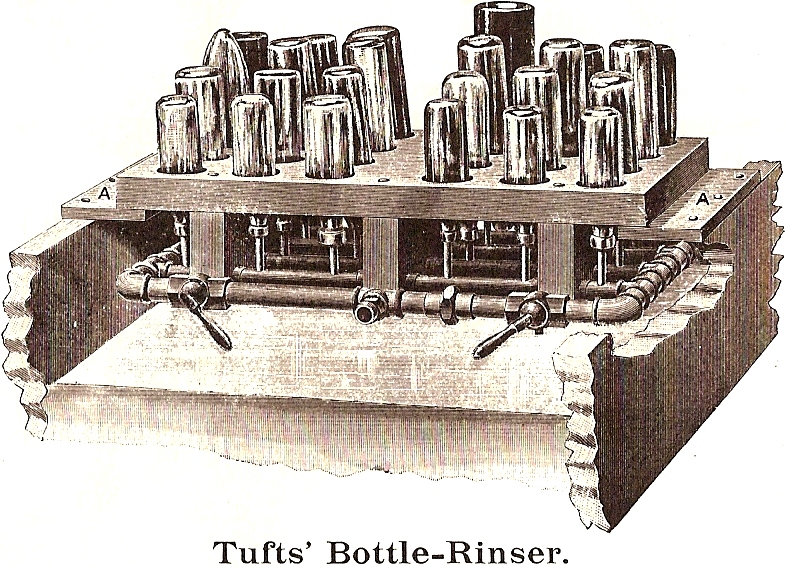
Tufts’
accompanying description indicated:
This simple and substantial bottle-rinser is intended
to be placed across a sink of any width greater than itself.
This is done by attaching to the sink the supports, marked ‘A’ in
cut, of necessary width.
The rinser is constructed of hard-wood and galvanized-iron tubing, and
is provided with two inlet-cocks, each side being entirely separate from
the other, so that water may, at the same time, be turned on at one side
and off at the other. It is
also provided with coupling to attach supply-pipe.
The rinser is arranged to take any size of bottle, and
hold it upright, as shown in cut.
When water is turned on at one side a powerful jet is
thrown inside each of the dozen bottles placed on it; and meanwhile the
dozen on the other size may be removed and replaced with others…Price,
$20.00
The following advertisement for The Sears Bottle Washer and Rinser (patented October 8, 1901) was placed in the October 5, 1903 National Bottlers' Gazette. Both of the pictured Hutchinson bottles have Hutchinson's Patent Spring Stoppers in place in their necks:
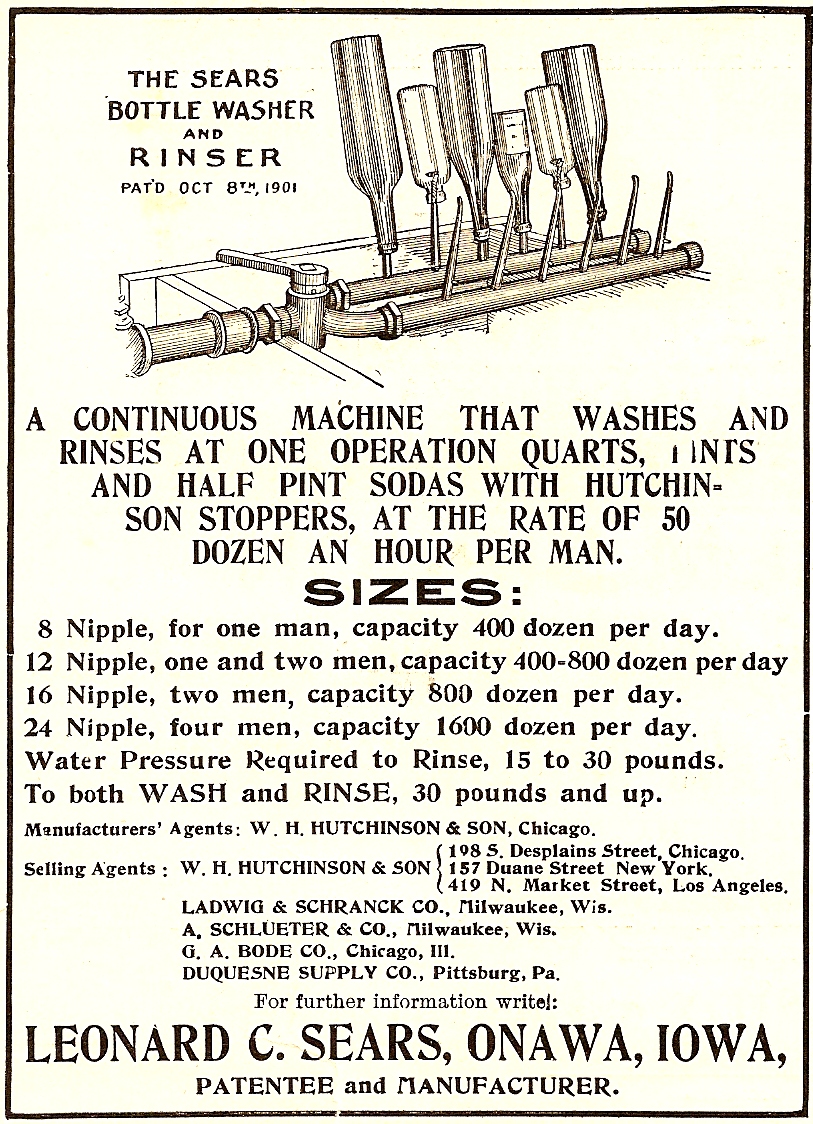
Here are examples of three bottle rinsing machines
offered in W. H. Hutchinson & Son’s 1908
Bottler’s Book.
The
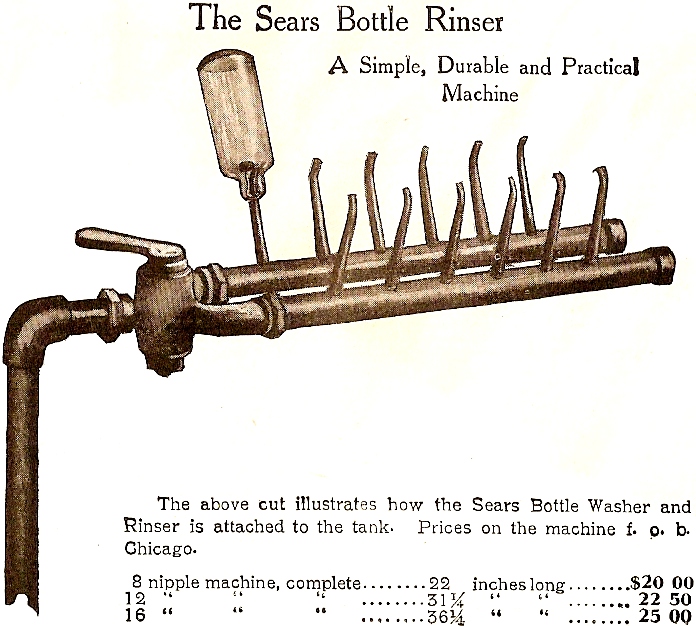
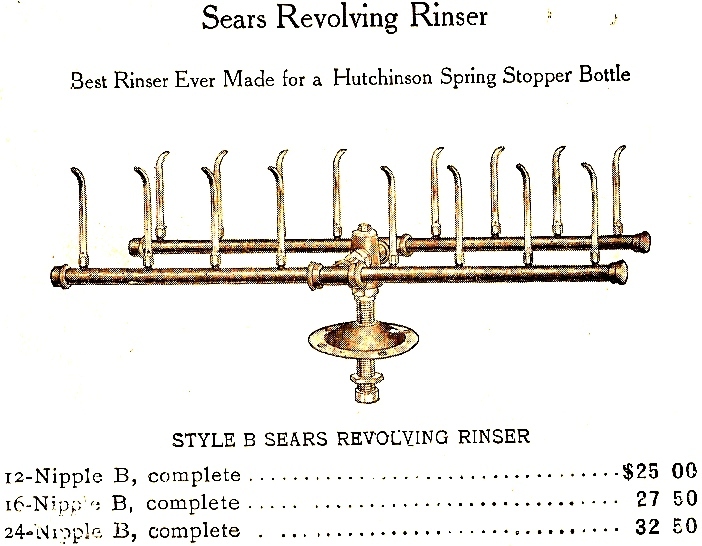
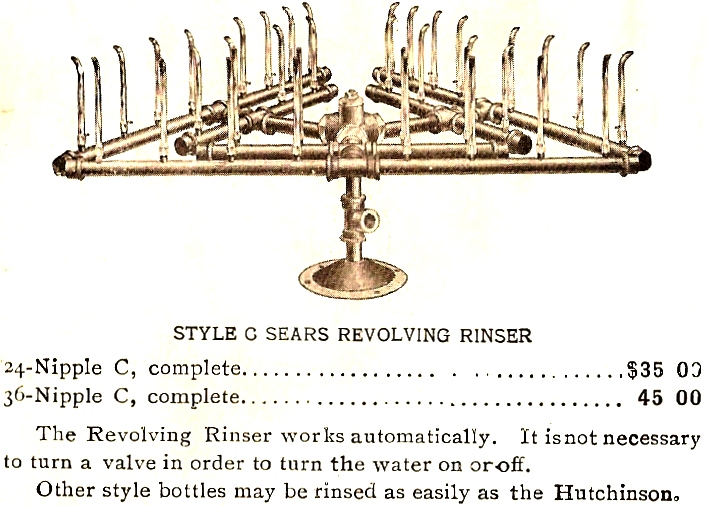
BOTTLER HINTS
These
TO CLEAN NECKS ON
By W. F. Stein, Stein’s Bottling
Works, Clarion,
Use ordinary clothes pins.
This you will find better than a neck brush, as you do not
have any bristles to contend with.
I have used this for ten years.
INSTRUCT YOUR CUSTOMERS.
By R. K. Chadwick, Seale Bottling
Works,
It is a good idea to have your customers pull up
the stoppers of
COMBINATION BRUSH.
By T. L. Jordan, Flat Top Bottling
Works, Welch,
Get just a common scrub brush and one of the small
brushes used in cleaning necks, fasten the small brush on back of
the larger one. Double
pointed tacks are good things to fasten with.
You can readily see that you can wash out the side of bottle
and the neck without having to put down one brush to pick up
another, consequently saving time in that way.

BOTTLING GLOVES.
By Jeff. D.
When washing bottles in a rush, wear cloth gloves
of some kind rubbing the water on the outside while handling same.
This will clean the outside of the bottle quite as well as
the brush and is a great saving of time.
The gloves will also protect the hands from being cut by
broken bottles which might be in the tub, as well as from the
numerous little scratches one gets.
Gloves made from a common brand of canton flannel usually
give best service.
STERILIZED BOTTLES.
By Frank P. Dalzell,
We make a connection from the boiler direct to the
bottle rinser. The
bottles are first rinsed and then the steam is turned on, thus
saving a second handling.
Of course some of the bottles break, especially in cold
weather when the water is quite cold, but the percentage of breaks
is very small compared with the time saved in handling the bottles.
 HutchBook.com
HutchBook.com